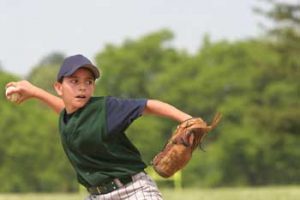
By Dr. John R. Mishock, PT, DPT, DC
Approximately, 40 million children and adolescence between the ages of 4 and 17 will soon begin participation in organized baseball throughout the world. Many of these young athletes develop elbow and/or shoulder injuries commonly seen in physical therapy clinics and orthopedic surgeon’s offices. Despite pitch count rules and guidelines, the incidence of youth injuries and surgeries is rising. The fastest growing segment of elbow surgeries (Tommy John) is in 15-19 year-olds at 57%, followed by 20 to 24-year-olds at 22% (American Journal of Sports Medicine, 2016). One study showed a 193% increase in the volume of elbow surgery from 2002 to 2011. (American Journal of Sports Medicine, 2017). Many of the adult throwing injuries seen in the MLB today are being attributed to overuse and injuries suffered as a youth player.
The greatest predictor of arm injury is throwing through fatigue. There is an astounding 36 times increase in arm injury when a pitcher throws while the arm and body is fatigued. (Pitch Smart, MLB 2015). A coach’s inability to recognize fatigue, playing on multiple teams at the same time, and not adhering to stringent pitch counts is the most common reasons for pitchers throwing through fatigue.
There is a long held belief that breaking pitches lead to arm injury. As it turns out, there are 3 studies that have shown that there is approximately 10% less stress on the elbow with the breaking pitches. (Orthopaedic Journal of Sports Medicine, 2013, American Journal of Sports Medicine, 2009, American Journal of Sports Medicine, 2008). It has been shown that those who throw the fastball more often increase their risk of arm injuries. MLB pitchers who threw more than 48% fastballs during practice and games had a significantly increased risk of elbow injury, which required surgery (Journal of Shoulder and Elbow Surgery, 2016). Another study showed that the greatest risk of needing elbow surgery in MLB pitchers was the greatest fastball velocity (American Journal of Sports Medicine, 44, 2016). The change up is the safest pitch, producing 5-10% less stress than the breaking pitches. The bottom line should always be to learn to throw strikes first, with less concentration on velocity. At the same time, there needs to be more emphasis on proper development of pitch mechanics and arm control across a variety of speeds, which reduces stress on the arm. Once there is a strong command of the strike zone with the fastball and the change-up a breaking pitch can be added.
If a pitcher throws greater than 8 months per year there is a 5 times increase of arm injury. If the pitcher throws on consecutive days they have more than 2.5 times greater risk of experiencing arm pain.(Pitch Smart, MLB 2015). Injured pitchers threw greater than 34 warm up pitches versus un-injured pitchers prior to a pitching outing. Injured pitchers threw in 4 or greater showcase tournaments versus un-injured pitchers who threw in 1. (American Journal of Sports Medicine, 2016).
In protecting the youth and adolescent baseball player from arm injury, the coach and parent must us a comprehensive approach of; appropriate pitch counts, recognizing pitcher fatigue, understanding proper pitch mechanics, knowing the athlete’s physical conditioning and previous injury status, and understanding the player’s overall throwing volume. This comprehensive understanding will give the athlete the best chance to keep the shoulder and elbow healthy throughout his or her baseball career. The parents must be vigilant in protecting their child from the pitching “abuse” which is commonly seen youth baseball. This much more than “winning” a baseball game it’s about the young athletes health and safety. It is this overuse at the youth level which has led to the near epidemic of elbow and shoulder injuries in MLB. The future MLB draft pick will need durability as much as he will need ability.
We can help!
Relieve pain, restore function
Call 610-327-2600 for a FREE Phone Consultation, or to schedule your appointment today!
6 Locations: Skippack, Gilbertsville*, Barto, Phoenixville*, Pottstown, and Limerick* (inside the Spring Valley YMCA).
Hours: 7:00am to 8:00pm, ALL locations, most days!
*Saturday Hours
Dr. Mishock’s book, “The Rubber Arm: Using science to increase pitch control, improve velocity and prevent elbow and shoulder Injuries.” This can be found at train2playsports.com.
